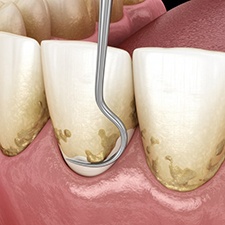
Periodontal Therapy – Allen, TX
Understanding Why Your Gum Health Matters

It’s easy to get caught up in the condition of your teeth and forget about your gums, but they are equally as important when it comes to your oral health. Without healthy gums, your teeth won’t stay in your mouth for very long, which is why we offer multiple treatments to manage gum disease should it develop at any point. If you notice any symptoms, such as bleeding while brushing, tenderness, soreness, or inflammation, please don’t hesitate to give us a call for periodontal therapy in Allen, TX!
Why Choose Allen Smile Design for Periodontal (Gum) Disease Treatment?
- Soft Tissue Laser Therapy Available
- Arestin Antibiotics for Faster Healing
- Dentists Always Dedicate Time to Patients
Symptoms of Periodontal Disease

Gum disease can be difficult to catch on your own, which is why it’s important to maintain routine visits at our dental office. However, if you notice any of the following, you should visit our dental office as soon as possible:
- Red or inflamed gums
- Bleeding gums while brushing, chewing or flossing, particularly for several days at a time
- Sore, tender or sensitive gums
- Gum recession (teeth appearing longer than usual)
- Changes in the way your denture fits
Diagnosis of Periodontal Disease

During your appointment, we’ll stay on the lookout for the common signs of gum disease as well as measure your current pocket depth. The deeper the pockets of your gums, the more severe your gum disease has become. Healthy mouths typically have a depth of 3 millimeters, while gums with a depth of 4 millimeters or more are suffering from gum disease or the more advanced form, periodontitis. We’ll also perform X-rays to confirm if bone loss is present.
Causes of Periodontal Disease

Gum disease most often occurs as a result of poor oral hygiene, but some patients can be more susceptible to it than others as a result of genetics as well. If you don’t brush twice a day with fluoridated toothpaste or floss daily, bacteria can feed on the sugars and starches in your mouth and develop plaque acids, which directly attacked teeth and gum tissue. Those who use tobacco or have poor diets can also expect a higher risk of gum disease.
Treatment of Periodontal Disease

Treatment can vary significantly depending on how severe your gum disease actually is. For example, if you have gingivitis, the earliest stage of gum disease, we would recommend methods to improve your oral care habits as well as a thorough cleaning at our dental office. For more advanced forms, we may recommend, scaling and root planing and antibiotic therapy as well as routine follow-up visits to make sure your gum disease is under control.

Arestin® Antibiotic Therapy
As part of your scaling and root planing treatment, we’ll also perform antibiotic therapy as a way to promote faster healing of your gum tissue and reduce the risk of your gums becoming infected again later. We’ll place a small amount of the antibiotic in the deep pockets of your gums so they can slowly release over time, healing your gums better than scaling and root planing alone.

Periodontal Maintenance
Keep in mind that gum therapy often takes more than one visit to complete. Not only do your gums need time to heal after initial treatment, but they also require retreatment every three to four months so they don’t become infected once again. We’ll always make sure to schedule follow-ups so we can monitor your condition and make sure your gum health improves.
Scaling & Root Planing

Scaling and root planing are the standard treatment for most advanced levels of gum disease. Scaling is the process of removing plaque and tartar from above and below the gum line, while root planing works to smooth out the roots of teeth so they can better re-attach to the gums, preventing the risk of future infection. In many instances of periodontal disease, going without treatment can increase the risk of your teeth becoming too loose or coming out completely, and Dr. Lewis wants to make sure her patients keep their natural pearly whites for as long as possible.
Do I Need Scaling & Root Planing?

For those experiencing the first stage of gum disease, or gingivitis, you can typically address the issue with everyday teeth cleaning practices like brushing and flossing. More serious cases of periodontal disease can likely require scaling and root planing, as the connective tissues attaching your gums to your teeth can become inflamed due to bacteria, which can create deep pockets if left unchecked. This treatment option is designed to remove any accumulated or trapped plaque and tartar from along the gum line and underneath it so that it has a chance to recover from infection.
The Process of Scaling & Root Planing

While both procedures are considered non-surgical and won’t require scalpels, our team will numb your mouth with a local anesthetic before starting scaling and root planing. This is so that you can remain entirely pain-free during both portions of your deep cleaning. Scaling involves Dr. Lewis removing any plaque from your teeth, both atop and underneath your gum line.
After the scaling portion, our team can then perform root planing to address the exposed root surfaces by smoothening and polishing them, fixing their rough texture. This will allow your gums to attach to your teeth much more easily while also making it challenging for bacteria to accumulate and develop gum disease in the future.
Aftercare Tips for Scaling & Root Planing

You can generally expect your mouth to still feel numb for a couple of hours after your deep cleaning. Typically, we recommend that patients avoid eating so that they don’t accidentally bite into their cheeks or tongue. After undergoing scaling and root planing, it’s best to rinse your mouth every day with warm salt water multiple times for the following week or more, as this will help keep bacteria and inflammation at bay while your gums heal.
Preventing Periodontal Disease

Gum disease can be hard to detect, but the good news is preventing gum disease is as easy as practicing daily brushing, flossing, and committing to routine dental cleanings and exams. While you should maintain a good at-home oral care routine, it also helps to consider the medications you take and whether or not they increase your risk for dry mouth. Dry mouth can increase your risk for tooth decay and gum disease. You’ll also need to make sure your diet is balanced and that you’re drinking plenty of plain water throughout the day.
Cost of Periodontal Treatment

Once we complete a detailed diagnosis of your current gum health, we’ll take the time to go over your necessary treatments before providing a detailed cost of your care. Since every patient is going to have their own unique needs, it’s important that we establish them ahead of providing a specific price of treatment. Regardless of your needs, we’ll make sure to help you create a financing plan that fits your budget.